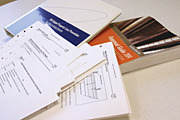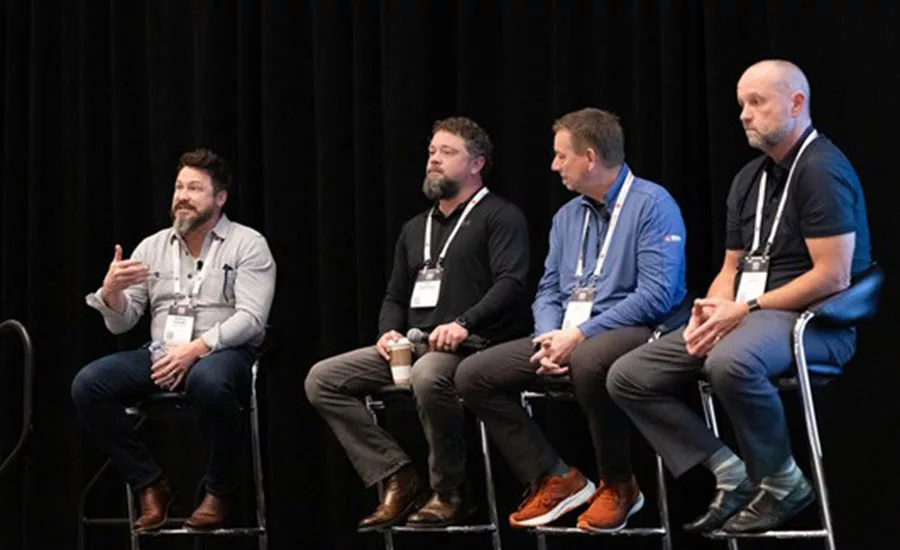Technical Details: Proper Roof Attachment
Wind damage occurs primarily at perimeters and corners and infiltrates the entire system. Generally, wind vortexes occur at the perimeter of the building, displacing perimeter components (flashings, wood nailers, metal coverings, etc.) and creating openings for wind entry. The wind moves through the system in a cross-directional pattern creating uplift and damage at points throughout the system. Wind uplift can also occur from below the deck in facilities that are damaged by wind from interior entry points, such as windows, doors, overhead doors, etc. Secondary wind damage can also occur at the roof from membrane protrusions created by wind-driven projectiles.
FM Standards
Wind damage to buildings and property loss became so prevalent in the 1970s that the insurance carrier Factory Mutual began studying wind forces. FM reported wind damage claims in excess of $282 million between 1970 and 1980. These losses led to the development of the Factory Mutual Research Corp.-which is now FM Approvals-Property Loss Prevention Data Sheets that provide guidelines for installation of roof systems to prevent substantial damage from severe weather.In addition to the design standards, FM also conducts testing to approve materials and systems. The materials and systems are tested (for a fee) to meet wind-uplift and fire standards. The membranes are typically tested in system configurations over different deck types and by using different insulations. FM charges a separate fee for all tests and each system configuration must pass on its own for individual certification. The specifier must determine that a proposed system has passed FM in the exact configuration that is specified. The approvals are based on systems-not separate components. FM design standards and testing procedures have been adopted as acceptable in the roofing industry.
Although FM provides loss prevention standards for fire, hail and roof loads, the organization is most recognized for wind uplift testing. The total roof system must be designed to comply with the standards at insulation and membrane attachment and at all perimeter flashings.
There are two common misconceptions associated with the FM wind uplift classifications. First, the classification denotation is the numeral "1," not the letter "I" as it is frequently referred to. The second misconception is what the uplift classes actually mean. The common misconception is that Class 1-60 can withstand 60-mile per hour wind speeds. This is incorrect. The determination is based on pounds per square foot of pressure that the system can withstand. This is determined during testing procedures. In this process, the complete roof system-including the deck-is secured to the frame of the wind uplift test apparatus. During the test procedure, compressed air is slowly introduced below the deck in increments of 15 psf. If the sample maintains 60 psf for one minute without damage it is classified as Class 1-60. The same procedure applies for Class 1-90, which must maintain 90 psf for one minute and Class 1-120, which must maintain 120 psf for one minute.
Wind Classifications
There are four wind classifications, which range from 39 mph to in excess of 300 mph. The most common type of wind is a gale force wind, which can vary in wind speed from 39 to 72 mph. These types of winds are steady in velocity and have sporadic gusts. Wind forces in combination with thunder, electric storms and heavy rainfall are referred to as squalls. Squalls can range up to 90 mph. Even though gales and squalls have the least amount of wind force of the four classifications, they contribute to over 70 percent of the wind-related claims per year.Hurricanes primarily occur in the Gulf and Atlantic costal regions and contribute to widespread damage. Most hurricanes form in the Atlantic as tropical storms, when they exceed 73 mph they reach hurricane status. There are five levels of hurricanes, which are categorized by wind speeds. Hurricanes typically occur from the end of May through November.
Tornadoes are severe squalls with the addition of a funnel (vortex). Wind speeds are high and typically immeasurable. They have been estimated to be between 200 to 300 mph within the vortex. They are most common in the central United States in the spring, however, they can-and have-occurred in other regions at other times of the year.
FM Approvals
FM Approvals have become industry standards for attachment of roof systems. NRCA, RCI, CSI and ASTM all reference FM Approvals in the attachment of roof systems. Furthermore, the International Building Code, its predecessor BOCA, and most other adapted building codes reference FM Approvals for materials and attachment methods on new and remedial roof assemblies. It may be best practice for applicators and designers to follow FM standards on all roof assemblies, even at non-FM insured facilities.FM determines roof system configuration and attachment methods through wind uplift approval ratings, which determine the actual field wind uplift pressure. The roof wind uplift rating is based on four factors:
Basic wind speed
Ground roughness coefficient
Roof uplift pressure
Adjustments to uplift pressures
The calculated pressure is applicable for the determination of the entire roof system-roof deck and all above-grade components. However, this procedure only determines attachment rates for the field of the roof. The pressures required for corners and perimeters must be calculated separately.
The procedure to determine wind uplift classifications on specific buildings during the design phase is based on a calculation that takes into account the basic wind speed in the geographical area, ground surrounding the building and the roof uplift pressure at the field of the roof. The building's height and perimeter construction is also considered. It is the responsibility of the specifier to complete these calculations. It is also the specifier's responsibility to determine the proper wind uplift classification for the building.
The standard method of determining the proper wind uplift pressures is by referencing FM charts and calculations included in Section 1-28 of the Loss Prevention Data Sheets. Following this method, applicators and designers can configure the proper roof system and attachment methods for a facility through use of charts, historical data and calculations.

RoofNav
In an effort to simplify the configuration of FM-approved roof systems, FM has developed RoofNav. RoofNav is a Web-based navigation tool that provides roofing professionals with guidance on how to identify, configure and install roofing assemblies in compliance with FM standards. Erik Scalavino of FM Approvals says, "RoofNav is designed to save users significant time, reduce costly human errors and increase their productivity."FM Approvals has assembled all of the information from the 900-page Building Materials section of the Approval Guide and the roofing information from the FM Global Property Loss Prevention Data Sheets on the Web-based navigation tool. George Smith of FM Approvals explains, "It takes all of the guesswork out of configuring an FM-approved roof. What once took two to three hours and hundreds of pages of reference material is now just a few minutes and mouse-clicks away."
RoofNav provides benefits for all roofing professionals: contractors, manufacturers and designers. Contractors and designers benefit from being able to produce accurate installation guidelines and access the latest FM approvals, anytime, anywhere. Manufacturers can track their competition and answer inquiries from the field.
RoofNav is easy to use and provides a ratings calculator to determine project-specific fire-, hail- and wind-uplift ratings. The program allows users to search approval assemblies or customize project-specific assemblies. Users can also search a product index that lists all approved product and manufacturer information, including the latest product developments. RoofNav provides contractors with an added feature: reports can be generated for specific system designs that contain a summary of the roof configuration, attachment details, safety information and installation guidelines. Roof configurations can be saved for future reference or retrieval for upcoming projects.
RoofNav, which was introduced in March of 2005, is provided on a subscription basis and is available exclusively through the Internet. Fore more information about RoofNav, contact FM Approvals at 877-364-6726 or visit www.roofnav.com.
Looking for a reprint of this article?
From high-res PDFs to custom plaques, order your copy today!


